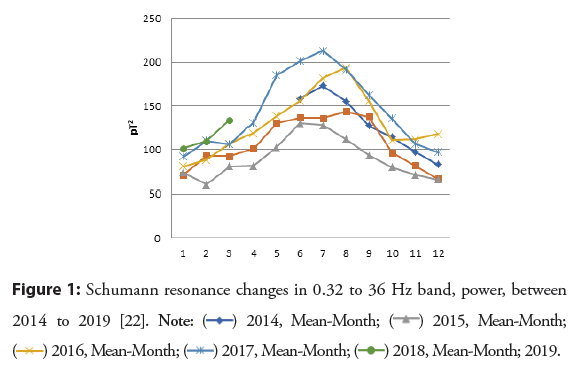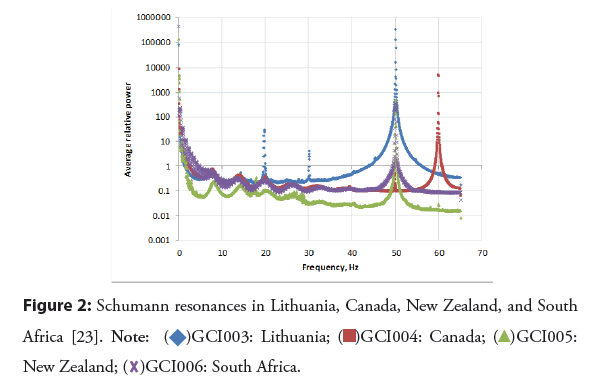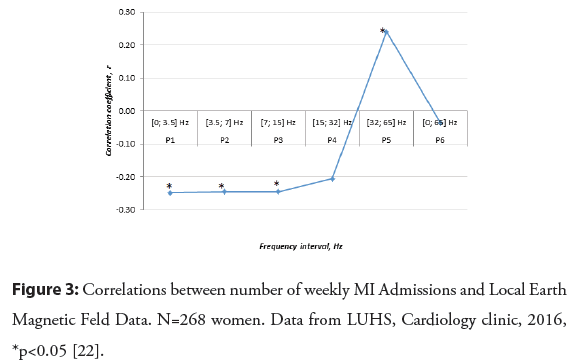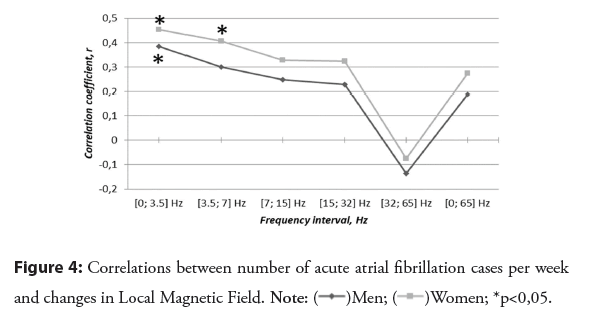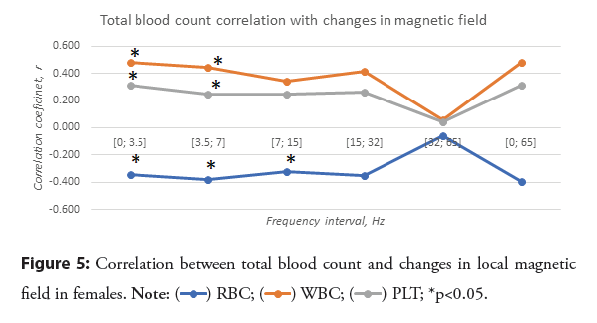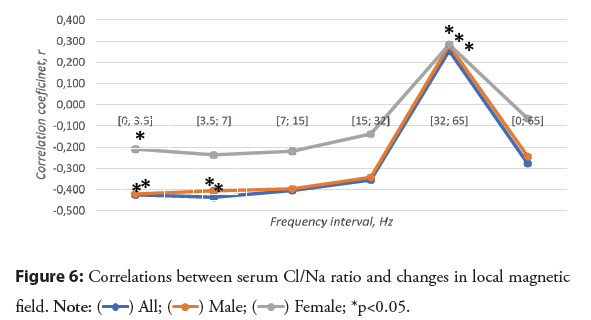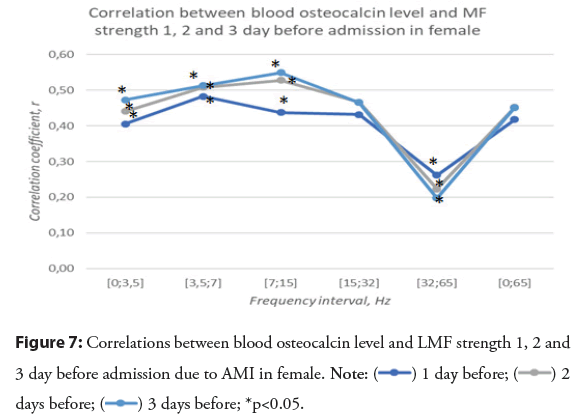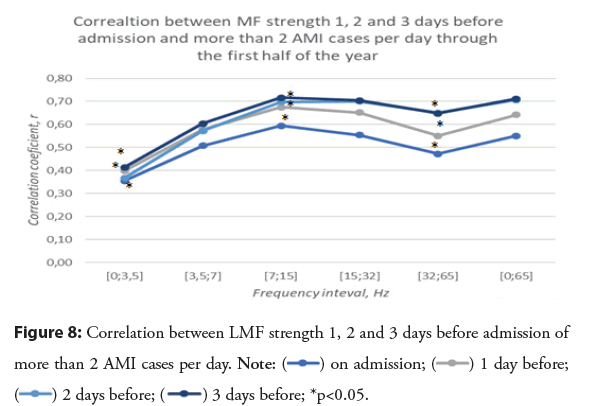Research Article - Interventional Cardiology (2022)
Cardiovascular System Interactions with the Local Earth Magnetic Field Fluctuation: A Cohort Study
- Corresponding Author:
- Greta Žiubrytė
Department of Cardiology, Hospital of Lithuanian University of Health Sciences Kaunas Clinics, Kaunas, Lithuania,
E-mail: greta.ziubryte@gmail.com
Received date: 03-Oct-2022, Manuscript No. FMIC-22-56810; Editor assigned: 05-Oct-2022, PreQC No. FMIC-22-56810 (PQ); Reviewed date: 19-Oct-2022, QC No. FMIC-22-56810;Revised date: 26-Oct-2022, Manuscript No. FMIC-22-56810 (R);Published date: 02-Nov-2022, DOI: 10.37532/1755-5310.2022.14(S12).305
Abstract
Introduction: Geomagnetic storms strongly affect the human cardiovascular system, misbalancing adaptive mechanisms and causing severe adaptive stress responses at all levels of body regulation. Most physiological changes occur after a defined period following geomagnetic climate alterations, this ‘delay period’ lasts for 2-3 days.
Methods and findings: In total, 4730 patients admitted between 2015 and 2017 due to Acute Coronary Syndrome (ACS) and acute onset of arrhythmias has been included into the study. Higher Time Varying Magnetic Field (TVMF) activity in low frequency ranges is associated with lower number of admissions due to ACS, while higher TVMF activity in high frequency ranges is associated with increased risk for ACS occurrence. The greater TVMF activity in low frequency ranges is associated with higher rates of admission due to cardiac arrhythmias. Additional ACS analysis showed that red blood cell count decreases with increased MF strength in low frequency ranges, while white blood cells and platelets count increases in the same MF frequency ranges. The highest serum osteocalcin level was found 3 days after certain MF strength changes in low frequency ranges in patients with ACS. Strong correlations were found between more than 2 cases of AMI per day and MF strength changes 2- and 3- days before admission.
Conclusion: Earth’s local magnetic field is strongly related to human cardiovascular system metabolism and neural regulation. Increased Magnetic field activity in low frequency ranges is associated with heart metabolism and may induce better cardiovascular health, while increased magnetic field activity in high frequency ranges leads to heart problems especially occurrence of ischemic heart disease and arterial hypertension.
Keywords
Cardiovascular system • Ischemic heart disease • Acute coronary syndrome • Acute atrial fibrillation • Arterial hypertension • Local earth’s magnetic field
Introduction
Geomagnetic climate changes undoubtedly affect living organisms [1-7]. It was noticed that birds, fish, and insects navigate in the environment mainly by Earth geomagnetic field oscillations [1]. Interestingly, Geomagnetic Field (GMF) impact on the tone of the vascular wall has been repeatedly proved, [2-7] highlighting that GMF changes independently to other geomagnetic climate factors strongly modulate Blood Pressure (BP) changes [2]. Even more, it was noticed that Geomagnetic Storms (GMS) created by solar flares [2] misbalancing adaptive mechanisms and causing severe adaptive stress responses most heavily impact cardiovascular system regulation mechanisms [8,9] manifesting as decrease of the Heart Rate Variability (HRV) and blood flow, and increase in platelet aggregation activity, coagulation, and blood viscosity even in healthy people [10].
Nevertheless, it has been shown in many studies that physiological changes occur with a delay after the change in magnetic or solar activity [8,10-13]. The phenomenon is called ‘delay phase’ and take from hours up to 2-3 days following GMC alterations [8,10-13]. Additionally, it was noticed that a diseased system lost its adaptative to fluctuation in the GMF mechanisms [14]. It was noticed that cardiovascular diseases significantly reduce subjects’ sensitivity to MF changes which may lead to critical health deteriorations [14]. Scientists have claimed that physiological changes are minimal if noticeable at all when it is normal susceptibility to MF changes [14].
Association between human beings and the magnetic environment could be explained by overlaps between human brain waves captured on an Electroencephalogram (EEG) and Schumann resonance waves [8,11,15-18] and field-line resonances. It was stated, that Schnumman resonances start at 7.83 Hz and there are 8 of all of them which overlap with EEG rhythms. Field-line resonance oscillations (0.1 Hz) corresponds to heart rhythm activity, and oscillations of the autonomic nervous system [8,15-18]. Andey, et al. [19] have observed the relation between GMF intensity changes and neurohumoral regulation in early 1990 and highlighted the autonomic nervous system ability to modulate the baroreceptor activity and regulate intracellular processes resulting in Blood Pressure (BP) regulatory reflex in both normal and cardiovascular diseases [20,21]. The negative effect of increased GMF disturbances on baroreceptors responsiveness may result in decreased Heart Rate Variability (HRV) and increased BP variability [18,21]. These processes may lead to higher mortality in patients with myocardial infarction [18,21,22]. Even more, isolation from magnetic field results in diastolic BP reduction of 2 mmHg and improvement of capillary blood flow at 17% [23]. If we assume that increased GMF intensity, increases vascular tone, and most possible, that the stronger the GMF, the greater vascular tone, which may progress to even life-threatening conditions. Interestingly, a stronger negative effect of the Local earth Magnetic Field (LMF) on onsets of Acute Atrial Fibrillation (AAF) has been observed in hypertensive patients [24-26]. Magnetic Field (MF) strength fluctuations resulting in HRV reduction and Heart Rate (HR) increase may provoke heart arrhythmias [3]. This tendency is most evident in hypertensive patients’ group [26]. It was recently found that increased MF activity in low frequency ranges is associated with increased number of acute atrial fibrillation and atrial flutter [20]. It appears, that a higher MF intensity in the low frequency ranges is associated with onsets of arrhythmia while in high frequency range–with ischemic cardiac events [20,22,27]. Despite various studies of GMF effects on the cardiovascular system there have been confusing results. Therefore, this study was aimed to further clarify the impact of the changes of LMF intensity on various cardiovascular disorders.
Materials and Methods
In total, 4,730 patients admitted due to acute cardiovascular disorder including Acute Coronary Syndromes (ACS) and Myocardial Infarction (MI) with or without ST segment elevation and unstable angina and acute onset of arrhythmias have been included into this single centre multivariate observational prospective study, which was executed between 1 January, 2015 and 31 December 2017 in Kaunas, Lithuania.
Patients’ demographic parameters including age and gender, medical history including comorbidities and previous cardiac procedures, laboratory, and instrumental test results, as well as treatment methods were collected from medical records during hospital stay period.
All patients according to their primary diagnosis have been divided into two groups: 1) Acute Coronary Syndrome (ACS) group consisted of 4,400 patients; 2) and arrythmias group which consisted of 330 patients. The first group was further divided into two subgroups according to ST segment changes. First-time MI patients from with ST segment elevation was subtracted, although certain neurohormonal biomarkers from this group was analysed for the expression of the ‘delay effect’.
Magnetometer data was obtained from the magnetometer located in Lithuania which was continuously collected by the Global Coherence Monitoring Network. The time varying MF was observed in two (north/south and east/west) orientations. Following HeartMath institute scientists’ recommendation east/west detectors data was used for analyses in this study. The Local Magnetic Field (LMF) strength has been measured in pico-Teslas (pT). Power of certain frequency interval was calculated in pT2. The LMF was analysed in five frequency ranges that overlap with the EEG ranges (Hz), but to differentiate those magnetic field frequency ranges which are in same range as the EEG bands we add an S in front: (SDelta) (0; 3.5 Hz), (STheta) (3.5; 7 Hz), (SAlpha) (7; 15 Hz), (SBeta) (15; 32 Hz), (SGamma) (32; 65 Hz). We also include a range (0; 65 Hz) where all frequency bands were summed in one, in order to observe correlations in summarised spectrum. Analogous indication of Schumann resonances was proposed [22].
Statistical analysis was performed using the software package SPSS 20.0. The chosen level of significance was p<0.05.
The local Ethical committee approval No. BEC-MF-126 20 was obtained.
Results
The first thing we observed in this study was that the strength of the resonant frequencies in local magnetic field, is continually changing (Figure 1). Tendencies of LMF weakening were observed between 2014 and 2016, when LMF was the weakest during the observational period. It was observed that an abrupt increase of LMF strength occurred from 2016 to 2017, and that since then the amplitude of the LMF resonances has continued to increase showing the highest ever observed values in 2019 (Figure 1). Moreover, it is noticeable that LMF reaches its highest peaks in July-August and decreases to lowest value in winter months-December and January. Scientists have suggested that people are able to better tolerate LMF increases in the spring season as compared to its decrease in the autumn [22].
Figure 1: Schumann resonance changes in 0.32 to 36 Hz band, power, between 2014 to 2019 [22].

Schumann resonances in four countries are shown in Figure 2. It is clearly seen that the peaks of resonances are the same all around the World and differ only in their intensities in the different frequency ranges. The most expressed LMF intensities are in SDeltha range (0-3 Hz, 5 HZ), which usually is related with Earth terrene fluctuations and in SGamma range (32 Hz-65 Hz), which is mostly related to country electricity networks frequency.
Figure 2: Schumann resonances in Lithuania, Canada, New Zealand, and South Africa [23].

A huge part of our study was based on ischemic cardiac events, which had a significant positive correlation between Acute Coronary Syndrome (ACS) and increased LMF activity in the high frequency range (SGamma). These tendencies are the best illustrated by number of acute myocardial infarction cases per week in relation with LMF changes (Figure 3). It was found that a higher LMF activity in the low frequency ranges is associated with lower number of admissions due to ACS, while a higher LMF activity in high frequency ranges is associated with increased risk for ACS occurrence. These tendencies remained the same during all seasons, with the only difference being in the level of expression and in the strength of correlation. It is interesting, that a greater LMF activity in the low frequency ranges was associated with higher rates of admission due to cardiac arrhythmias (Figure 4).
Figure 3: Correlations between number of weekly MI Admissions and Local Earth Magnetic Feld Data. N=268 women. Data from LUHS, Cardiology clinic, 2016, *p<0.05 [22].
Figure 4: Correlations between number of acute atrial fibrillation cases per week and changes in Local Magnetic Field.
In patients admitted due to Acute Myocardial Infarction (AMI), several additional analyses were conducted. Interesting results were found in the analyses of blood test parameters’ and the associations with changes in LMF strength. It was observed that total blood count significantly correlates with LMF changes in low frequency range. Red blood cells count decreases with increased LMF strength in low frequency ranges, while white blood cells and platelet counts increases in the same frequency ranges (Figure 5). Completely different results were found in an analyses of serum Chlorine to Natrium ratio (Cl/Na). It replicated admission due to ACS results, showing moderate to strong negative correlations with the low frequency ranges and moderate positive correlations in the SGamma range (Figure 6). This suggests that Cl/Na is strongly associated with occurrence of AMI. Similar results have been found in analysis of the blood osteocalcin levels (Figure 7).
Osteocalcin is released from bones in presence of acute stress and starts to act in several minutes to modify overall body metabolism, preparing it to deal with stressful situations. In other words, osteocalcin may be considered as a stress hormone. It is not surprising that serum osteocalcin level is elevated in patients suffered from AMI. Nevertheless, this study has shown that in patients with AMI the highest serum osteocalcin levels were found 3 days after certain LMF strength changes occurred in the low frequency ranges. This part of our analyses has strongly confirmed the existence of a ‘delay effect’ lasting for 2-3 days. This means, that it takes about 2-3 days for the expression of these blood changes to occur after the change in the LMF strength. Impressive results were found in sub-analysis where we focused only on days when more than 2 AMI cases were admitted, pretending that a smaller number of cases might only be coincidence and unrelated to changes in LMF activity. Strong significant correlations (r>0.8, p<0.05) were found between the number of cases admitted per day and the LMF strength changes 2- and 3- days before admission (Figure 8).
Discussion
This is the first study we are aware of that focused on the correlations between cardiovascular function and changes in LMF strength in different frequency ranges and at different fractal levels. Moreover, there are only a few publications on changes in the local MF impact on human health [24,22-27], while many publications analyse the impact of the disturbances in the Global MF on living organisms.
It is known that not only enhancement but also weakening of the resonant frequencies in the magnetic field can adversely affect the body and that the direction of the LMF intensity change has an impact [20]. Clearly, increased LMF activity in low frequency ranges has a positive effect on the course of Ischemic Heart Disease (IHD) [20,22-27] but may increase risk of acute arrhythmias [24]. This study has confirmed that higher LMF intensity in the high frequency ranges is associated with higher number of admissions due to ACS. Interestingly, scientists have found that more diffuse coronary artery disease might be linked to higher LMF intensity in high frequency ranges [23]. The same tendencies are also associations between troponin I and the LMF. This let presume that a higher LMF intensity in high frequency range is associated with more severe deterioration of patients with Chronic Heart Disease (CHD) health condition [27]. Scientists analysing LMF, have concluded that LMF in low frequency ranges has positive influence on patients with CHD wellbeing [10]. It has recently been found that endothelial function is enhanced by LMF oscillations at extremely low frequencies (0.01 Hz-0.02 Hz) [28]. These Ultra-low frequencies are in the same frequency range of endothelial vibrations [10]. LMF fluctuations that coincide with endothelial vibrations, appears to activate endothelium, and improve its function [10]. Naturally, when endothelial function is improved, rheological properties of the blood also improve, inhibiting pathogenetic mechanism of ACS [28]. Moreover, Gmitrov, et al. have found that healthy endothelium releases more endogenous NO, which is critically important in maintenance of normal BP [18] and endothelial dysfunction is known as an initiating mechanism of atherosclerosis development [28]. Circulating Low Density Lipoprotein (LDL) is not able to enter beneath the endothelium since it is healthy. Thus, healthy endothelium prevents atherosclerotic plaque formation and ICH development [28]. As a good endothelium function is crucial in atherosclerosis prevention, it is particularly important to elucidate environmental factors that may have a positive and negative effect on endothelial function. It was hypothesised that industrially generated low-frequency MF generators could improve endothelial function and possibly prevent or at least slowed the progression of atherosclerosis, but the evidence are scarce yet [29].
It is impossible to conclude unambiguously, but it is clear, each person interacts with the environment in their own manner. So, concluding this report we only can talk about overall tendencies. Different people entered the study at different stages and times. LMF as well as the overall environment around us is constantly changing, so even at similar numeric values of LMF osculation amplitudes, human exposure to it might be drastically different. However, looking at general result trends we may confirm [14,22-27,29-31] that stronger LMF in high frequency ranges (32-65 Hz) adversely affects individuals with IHD.
Despite its novelty, this research has some limitations. First, the direction and strength alteration have not been included into our research. Second, we did not include adequate control group consisted of healthy people.
Conclusion
Each living organism is surrounded by a micro and macro environment, which undoubtedly influence our health. Individual human interactions with the environment may result in both improved and deteriorated health. Changes in the resonant frequencies in the Local earth’s magnetic field has huge influence on human cardiovascular system metabolism and neural regulation. Increased magnetic field activity in low frequency ranges improves heart metabolism and results in better cardiovascular health, while increased magnetic field activity in high frequency ranges leads to heart problems especially to occurrence of ischemic heart disease and arterial hypertension.
References
- Beason R, Nicholas J. Magnetic orientation and magnetically sensitive material in a transequatorial migratory bird. Nature. 309: 151-153 (1984).
- Ozheredov VA, Chibisov SM, Blagonravov ML, et al. Influence of geomagnetic activity and earth weather changes on heart rate and blood pressure in young and healthy population. Int J Biometeorol. 61(5): 921-9 (2017).
[CrossRef] [Google Scholar] [PubMed]
- Gurfinkel Y, Breus T, Zenchenko T, et al. Investigation of the effect of ambient temperature and geomagnetic activity on the vascular parameters of healthy volunteers. Open J Biophys. 2(2): 46-55 (2012).
[Google Scholar] (All versions)
- Zenchenko TA, Skavulyak AN, Khorseva NI, et al. Characteristics of individual reactions of the cardiovascular system of healthy people to changes in meterological factors in a wide temperature range. Izvestiya, Atmos Ocean Phys. 49: 783-98 (2013).
- Breus TK, Gurfinkel YI, Zenchenko TA, et al. Parameters to meteorological and geomagnetic factors. Izvestiya, Atmos Ocean Phys. 46(8): 965-972 (2010).
- Breus TK, Baevskii RM, Chernikova AG. Effects of geomagnetic disturbances on humans functional state in space flight. J Biomed Sci Eng. 5: 341-355 (2012).
- Ozheredov VA, Breus TK, Gurfinkel YI, et al. Influence of some weather factors and geomagnetic activity on the development of severe cardiological pathologies. Biophysics. 55(1): 110-119 (2010).
- Vencloviene J, Babarskiene RM, Kiznys D. A possible association between space weather conditions and the risk of acute coronary syndrome in patients with diabetes and the metabolic syndrome. Int J Biometeorol. 61: 159 (2017).
- Breus TK, Baevskii RM, Chernikova AG. Effect of geomagnetic disturbances on humans functional statei n space flight. I Biomed Sci Eng. 5: 341-55 (2012).
- Zenchenko TA, Poskotinova LV, Rekhtina AG, et al. Relation between microcirculation parameters and Pc3 geomagnetic pulsations. Biophysics. 55(4): 646-651 (2010).
[Google Scholar] (All versions) [PubMed]
- Dimitrova S, Stoilova I, Georgieva K, et al. Solar and geomagnetic activity and acute myocardial infarction morbidity and mortality. Fundam Space Res. 8: 161-165 (2009).
- Mavromichtaki H, Papailiou M, Dimitrova S, et al. Space weather hazards and their impact on human cardio-health state parameters on earth. Nat Hazards. 64: 1447-1459 (2012).
- Katsavrias C, Preka-Papadema P, Moussas X, et al. Helio-geomagnetic influence in cardiological cases. Adv Space Res. 51: 96-106 (2013).
- Alabdulgader A, McCraty R, Aktinson M, et al. Human heart rhythm sensitivity to earth local magnetic field fluctuations. J Vibroengineering. 17(6): 3271-9 (2015).
- Nakayama S, Atsuta S, Shinmi T et al. Pulse-driven magnetoimpedance sensor detection of biomagnetic fields in musculatures with spontaneous electric activity. Biosens Bioelectron. 27(1): 34-39 (2011).
[CrossRef] [Google Scholar] [PubMed]
- Uchiyama T, Nakayama S. Magnetic sensors using amorphous metal materials: Detection of premature ventricular magnetic waves. Phys Rep. 1(2): e00030 (2013).
[CrossRef] [Google Scholar] [PubMed]
- McCraty R, Deyhle A. The Global coherence initative: Investigating the dynamic relationship between people and earth‘s energetic systems in bioelectromagnetic and subtile energy medicine. (2015).
- Gmitrov J, Gmitrova A. Geomagnetic field effect on cardiovascular regulation. Bioelectromagnetics. 25: 92-101 (2004).
[CrossRef] [Google Scholar] [PubMed]
- Adey WR. Electromagnetic fields and the essence of living systems. Modern Radio Science. (1990).
- Liboff AR. A role for the geomagnetic field in cell regulation. Electroman Biol Med. 29: 105-12 (2010).
- Gaetani R, Ledda M, Barile L, et al. Differentiation of human adult cardiac stem cells exposed to extremely low-frequency electromagnetic fields. Cardiovasc Res. 82(3): 411-20 (2009).
[CrossRef] [Google Scholar] [PubMed]
- Jaruševičius G, Rugelis T, McCraty R, et al. Correlation between changes in local earth‘s magnetic field and cases of acute myocardial infarction. Int J Environ Res Public Health. 15(3): 399 (2018).
[CrossRef] [Google Scholar] [PubMed]
- Gurfinkel YI, At’kov OY, Vasin AL et al. Effect of zero magnetic field on cardiovascular system and microcirculation. Life Sci Space Res. 8: 1-7 (2016).
[CrossRef] [Google Scholar] [PubMed]
- FeinLeib M, Rogot F, Sturrock PA. Solar activity and mortality in the United States. Int J Epidemiol. 4: 227-9 (1977).
[CrossRef] [Google Scholar] [PubMed]
- Claeys MJ, Coenen S, Colpaert C, et al. Environment triggers of acute myocardial infarction: Results of a nationwide multiple-fatorial population study. Acta Cardiol. 70(6): 693-701 (2015).
- Žiubrytė G, Jaruševičius G, Jurjonaitė J, et al. Correlations between acute atrial fibrilation and local earth magnetic field strength. J Complex Health Sci. 2(1): 31-41 (2018).
- Žiubrytė G, Jaruševičius G, Landauskas M, et al. The local earth magnetic field changes impact on weekly hospitalization due to unstable angina pectoris. J Complex Health Sci. 1(1): 16-25 (2018).
- Rafieian-Kopaei M, Setorki M, Doudi M et al. Atherosclerosis: Process, indicators, risk factors and new hopes. Int J Prev Med. 5(8): 927-46 (2014).
[Google Scholar] [PubMed]
- Tousoulis D, Antoniades C, Stefanadis C. Evaluating endothelial function in humans: A guide to invasive and non-invasive techniques. Heart. 91(4): 553-8 (2005).
[CrossRef] [Google Scholar] [PubMed]
- Global coherence research: The science of interconnectivity. Heart Math® Institute. (2022).
- Cornelissen G, McCraty R, Atkinkson M, et al. Gender differences in circadian and extracircadian aspects of Heart Rate Variability (HRV). (2010).
